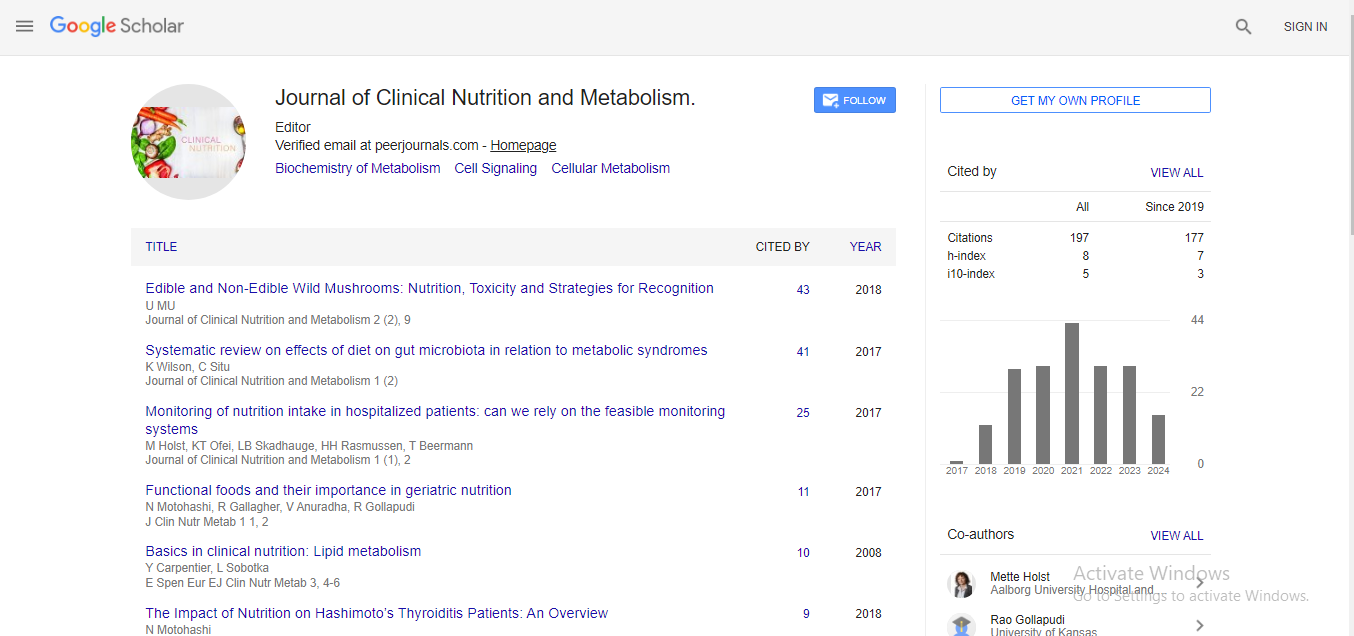Opinion Article, J Clin Nutr Metab Vol: 6 Issue: 2
Prenatal Exposure to the Dietary Supplement
*Corresponding Author: Keiji Sugihar
Department of Biochemistry, University of Nairobi, Nairobi, Kenya
Email: KeijiSugihara@gmail.com
Received date: 01-March-2022, Manuscript No. JCNM-22-59774;
Editor assigned date: 03- March-2022, PreQC No. JCNM-22-59774 (PQ);
Reviewed date: 17- March-2022, QC No JCNM-22-59774;
Revised date: 22- March-2022, Manuscript No. JCNM-22-59774 (R);
Published date: 29- March-2022, DOI:10.35841/jcnm- 6.1.90.
Citation: Sugihara K (2022) Prenatal Exposure to the Dietary Supplement. J Clin Nutr Metab 6:2
Keywords: Nutrition Physiology and Metabolism, Cellular and Molecular Metabolism, Nutrition and Endocrinology, Metabolic Disorders
Description
Malnutrition in rehabilitated cases is a problem that requires attention in the health sector in order to ameliorate issues, taking exploration and evaluation of the costs and large-scale effectiveness of the use of remedial interventions, especially in cases of malnutrition. Malnutrition requires acceptable and timely nutritive, as it's connected to a wide range of functional differences, medical complications and internal health problems, as well as increased threat of health complications similar as pressure ulcers, surgical point infections, urinary tract infections, adverse impact on internal health, depression and reduced quality of life. Thus, an optimal nutritive care process with costs that contribute to the sustainability of hospitals, contributes to reduce the complications associated with countries of malnutrition in oncological pathologies, similar as infections, increased sanitarium stay and costs of care. One of the main tools to carry out the executive and directorial operation for the decision making related to the products or services of a sanitarium institution, as far as its costs, profit perimeters, volumes, tariffs is to apply a going system. An illustration is the case of the methodology of the system, which has taken on a great deal of significance in recent times, and which since the 1980s has been known in the United States as an executive and directorial tool that made it possible to break numerous of the problems presented with traditional cost methodologies, substantially the distribution of circular costs, which suggested having a much more effective medium for their distribution surfaced, which is proposed as an volition to grease the objectification of data in a going system.
Synergistic Hypoglycemic
An indispensable is proposed to grease the distribution of costs using the practical capacity and not the theoretical capacity of the ABC, using formulas that allow to establish fluently the time that people devote to the Conditioning and taking into account the number of conditioning that they carry out, for which equations associated to the available information are configured. This new model, according to its authors, is proposed as a tool that is important simpler, cheaper and further far- reaching than the ABC methodology, with a lesser vision of costs, since it helps to determine unused capacity to allocate further conditioning to workers with underused time, and to increase the productivity of care services, as a donation to the present study object of a nutrition service, which could come a reference for the other services of sanitarium institutions. The TDABC model includes the costs of furnishing capacity and the time demanded to carry out an exertion, making it possible to determine unused capacity in care processes, considering practical capacity, and is a useful tool for health service delivery institutions. Vitamin D was discovered in the early 20th century. Since that time, it has been the subject of expansive exploration by both the scientific and clinical communities. Using formulas that allow to fluently establishing the time that people devote to the conditioning and taking into account the number of conditioning they carry out, for which equations are configured associated to the information available in the information systems of the institution, which grease its durability and analysis.
Vitamin D
Vitamin D is generally known for its regulation of serum calcium and phosphorous situations and its Capability to help rickets. The development of molecular and inheritable technology has allowed experimenters to look at the goods of vitamin D on other organ systems. Vitamin D receptors have been plant on colorful organs in the mortal body and it has been estimated that vitamin D regulates around 250 genes. Vitamin D exploration continues to be an open field where clinicians look to achieve a complete understanding of vitamin D function and its benefits in mortal health. A further thorough understanding of the metabolism and physiology of vitamin D can reveal its part in complaint and overall health. Although important progress has been made in our understanding of vitamin D, numerous challenges remain. Spectroscopy as sensors, have been meliorated to quantify the amount of vitamin D, and its metabolites, in specific tissues, such a serum. Still, it would be more important to known a case’s total store of Vitamin D in all apkins, which is much further delicate to determine. Accumulate in adipose towel, and live in a free form within the serum. Birth and discovery styles still struggle to regard for all those forms. In addition to dimension challenges, questions remain about what situations of vitamin D are sufficient. Indeed with that in mind, there's a growing agreement that vitamin D insufficiency is wide throughout the world’s population. Still, there isn't agreement as to the most effective lozenge and means of administering vitamin D to increase and maintain healthy vitamin D Situations. When the relationship between cure administration and physiological response can be easily defined, vitamin D dosing
 Spanish
Spanish  Chinese
Chinese  Russian
Russian  German
German  French
French  Japanese
Japanese  Portuguese
Portuguese  Hindi
Hindi 